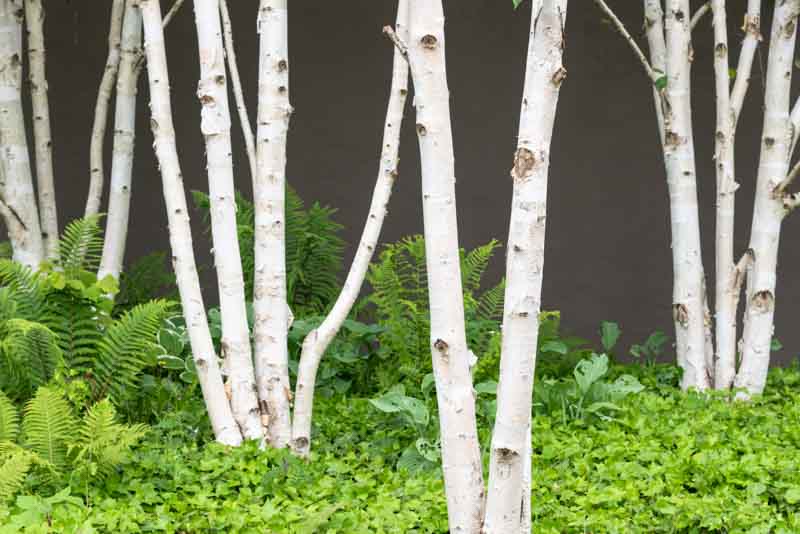Discovering issues with your Betula (Birch) tree? Learn to identify and address common problems such as borer infestations, aphids, fungal diseases, and environmental stressors.
Belonging to the Betula genus, birch trees captivate with their unique, often shedding, bark and refined, airy silhouettes. Indigenous to diverse regions such as North America, Europe, and Asia, they are versatile to varying climates, though they flourish most in cooler environments. Birches can manifest as petite shrubs or majestic trees reaching up to 80 feet, and their growth patterns span from upright to weeping.
Their leaves, simple yet serrated, transition to brilliant yellows come autumn.
Elongated flower structures, known as catkins, grace these trees from late spring to early summer, drawing a medley of pollinators.
The tree’s skin or bark is its standout feature, ranging in hues from snowy white to ash-gray, often shedding in delicate paper-like sheets.
Beyond their aesthetic appeal, birch trees have functional benefits: their timber is sought-after for crafting furniture, and their sap can be transformed into sweet syrup. A versatile and enchanting choice for diverse landscapes.

Birch leaves can exhibit various symptoms, including browning, curling, and spots. These issues often result from pests, diseases, or environmental stressors.
Birch tree trunk or branch issues can manifest as cracks, cankers, and oozing sap, often indicative of fungal diseases or pest infestations.
For all of these symptoms, it’s essential to monitor the tree’s health and consult with an arborist or tree specialist if there are significant concerns.
The bronze birch borer is a serious pest of birch trees. You may want to consider planting disease-resistant tree alternatives to birch less susceptible to borer attacks and offer comparable aesthetic appeal with vibrant foliage, ensuring a healthy and attractive landscape.
| Hardiness |
2 - 9 |
|---|---|
| Heat Zones |
1 - 8 |
| Climate Zones | 1, 1A, 1B, 2, 2A, 2B, 3, 3A, 3B, 4, 5, 6, 7, 8, 9, 14, 15, 16, 17, A1, A2 |
| Plant Type | Shrubs, Trees |
| Plant Family | Betulaceae |
| Genus | Betula |
| Exposure | Full Sun, Partial Sun |
| Season of Interest |
Spring (Early, Mid, Late) Summer (Early, Mid, Late) Fall Winter |
| Maintenance | Low |
| Water Needs | Average |
| Soil Type | Chalk, Clay, Loam, Sand |
| Soil pH | Acid, Alkaline, Neutral |
| Soil Drainage | Moist but Well-Drained, Well-Drained |
| Characteristics | Showy |
| Tolerance | Drought, Deer, Rabbit |
| Attracts | Bees, Birds, Butterflies |
| Landscaping Ideas | Beds And Borders |
| Garden Styles | City and Courtyard, Informal and Cottage, Prairie and Meadow, Traditional Garden |
| Hardiness |
2 - 9 |
|---|---|
| Heat Zones |
1 - 8 |
| Climate Zones | 1, 1A, 1B, 2, 2A, 2B, 3, 3A, 3B, 4, 5, 6, 7, 8, 9, 14, 15, 16, 17, A1, A2 |
| Plant Type | Shrubs, Trees |
| Plant Family | Betulaceae |
| Genus | Betula |
| Exposure | Full Sun, Partial Sun |
| Season of Interest |
Spring (Early, Mid, Late) Summer (Early, Mid, Late) Fall Winter |
| Maintenance | Low |
| Water Needs | Average |
| Soil Type | Chalk, Clay, Loam, Sand |
| Soil pH | Acid, Alkaline, Neutral |
| Soil Drainage | Moist but Well-Drained, Well-Drained |
| Characteristics | Showy |
| Tolerance | Drought, Deer, Rabbit |
| Attracts | Bees, Birds, Butterflies |
| Landscaping Ideas | Beds And Borders |
| Garden Styles | City and Courtyard, Informal and Cottage, Prairie and Meadow, Traditional Garden |
Create a membership account to save your garden designs and to view them on any device.
Becoming a contributing member of Gardenia is easy and can be done in just a few minutes. If you provide us with your name, email address and the payment of a modest $25 annual membership fee, you will become a full member, enabling you to design and save up to 25 of your garden design ideas.
Join now and start creating your dream garden!
Create a membership account to save your garden designs and to view them on any device.
Becoming a contributing member of Gardenia is easy and can be done in just a few minutes. If you provide us with your name, email address and the payment of a modest $25 annual membership fee, you will become a full member, enabling you to design and save up to 25 of your garden design ideas.
Join now and start creating your dream garden!